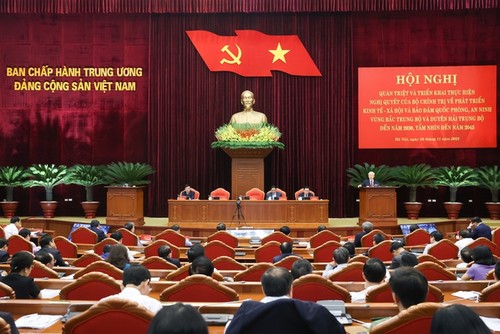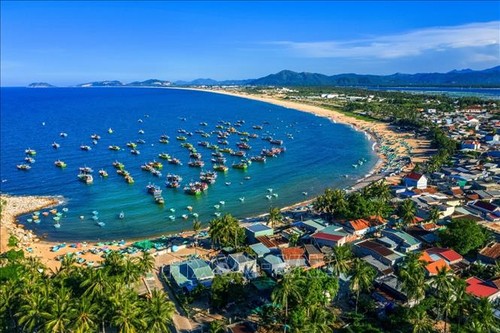 Resolution 26 of the Politburo defines the goal that by 2030 the north-central and central coastal regions will have a more dynamic, stronger, and more sustainable marine economy. Photo: VGP/Nhat Bac Resolution 26 of the Politburo defines the goal that by 2030 the north-central and central coastal regions will have a more dynamic, stronger, and more sustainable marine economy. Photo: VGP/Nhat Bac
|
The north-central and central coastal regions comprise 14 coastal provinces and cities from Thanh Hoa to Binh Thuan which occupy nearly 29% of Vietnam’s area. Their 1,800 km of coastline constitute more than 55% of Vietnam's total coastline. The region includes deep-water ports, islands, island clusters, and archipelagos, including Hoang Sa (Paracel), Truong Sa (Spratly), Ly Son, and Cu Lao Cham.
Marine economy
Resolution 26 clearly defines the goal that by 2030 the north-central and central coastal regions will have a more dynamic, stronger, and more sustainable marine economy; a coordinated and modern socio-economic infrastructure; and a number of major industrial, service, and international cooperation centers with coastal economic zones and coastal urban systems of national and regional standards. It will serve as a gateway to the sea from Vietnam’s Central Highlands and from Laos.
By 2045, it will be a region of rapid and sustainable development, strong in marine economy, with a number of major industrial, service, and international cooperation centers on par with Asia, modern coastal economic zones, and a smart, sustainable coastal urban system.
Tran Tuan Anh, Head of the Party Central Committee’s Economic Commission, said:“It must be a region whose development is based on the benefits of the marine economy and must thrive from the sea. Capitalizing on potentials of the marine economy must be combined with building economic corridors so that Vietnam will have truly developed coastal economic zones.”
In July 2022 the Government approved a project to develop marine economic clusters together with building strong marine economic centers until 2030. The project identifies three marine economic clusters: the first in the north-central region covering Nghe An and Ha Tinh province, the second in the central coastal region focusing on Da Nang city and Thua Thien-Hue province, and the third in the south-central region involving Khanh Hoa and South Phu Yen province.
In each cluster, priority industries and fields are selected to fully tap the advantages of local terrain and available resources.
 Xuan Hai fishing wharf (Song Cau town, Phu Yen province). Photo: VNA Xuan Hai fishing wharf (Song Cau town, Phu Yen province). Photo: VNA
|
Transformation of localities
Localities have taken specific steps to unlock their geographical advantages and marine economic potentials. Quang Binh province has planned, invested in, or called for investment in new industrial parks and coastal urban areas: Northwest Quan Hau Industrial Park and Cam Lien Industrial Park and the ecological urban areas of Quang Phu, Bao Ninh, and Hai Ninh.
Khanh Hoa estimates that its marine economic sectors currently contribute more than 80% of the province's GRDP and revenue from tourism services makes up a relatively large share of its economy. Khanh Hoa’s three key economic zones are now linked with three famous bays: Van Phong, Cam Ranh, and Nha Trang.
Nguyen Tan Tuan, Chairman of the Khanh Hoa provincial People's Committee, said:“Khanh Hoa will shift its economic structure in the next five years by forming modern industrial parks and developing high-quality agriculture and new tourism products. Van Phong Economic Zone still has a huge potential. Covering 150,000ha of land with clear and modern planning, Van Phong will surely become a very attractive destination, an open economic zone with a deep-water port. We also have Truong Sa Island district with a large fishing ground, which will be developed for aqua farming and processing.”
A Phu Yen province official said the South Phu Yen Economic Zone, one of Vietnam’s eight key coastal economic zones, has invested a great deal in infrastructure. As Vung Ro seaport is being upgraded, Phu Yen also plans to make the Bai Goc deep-water seaport capable of receiving ships of up to 50,000 tons.